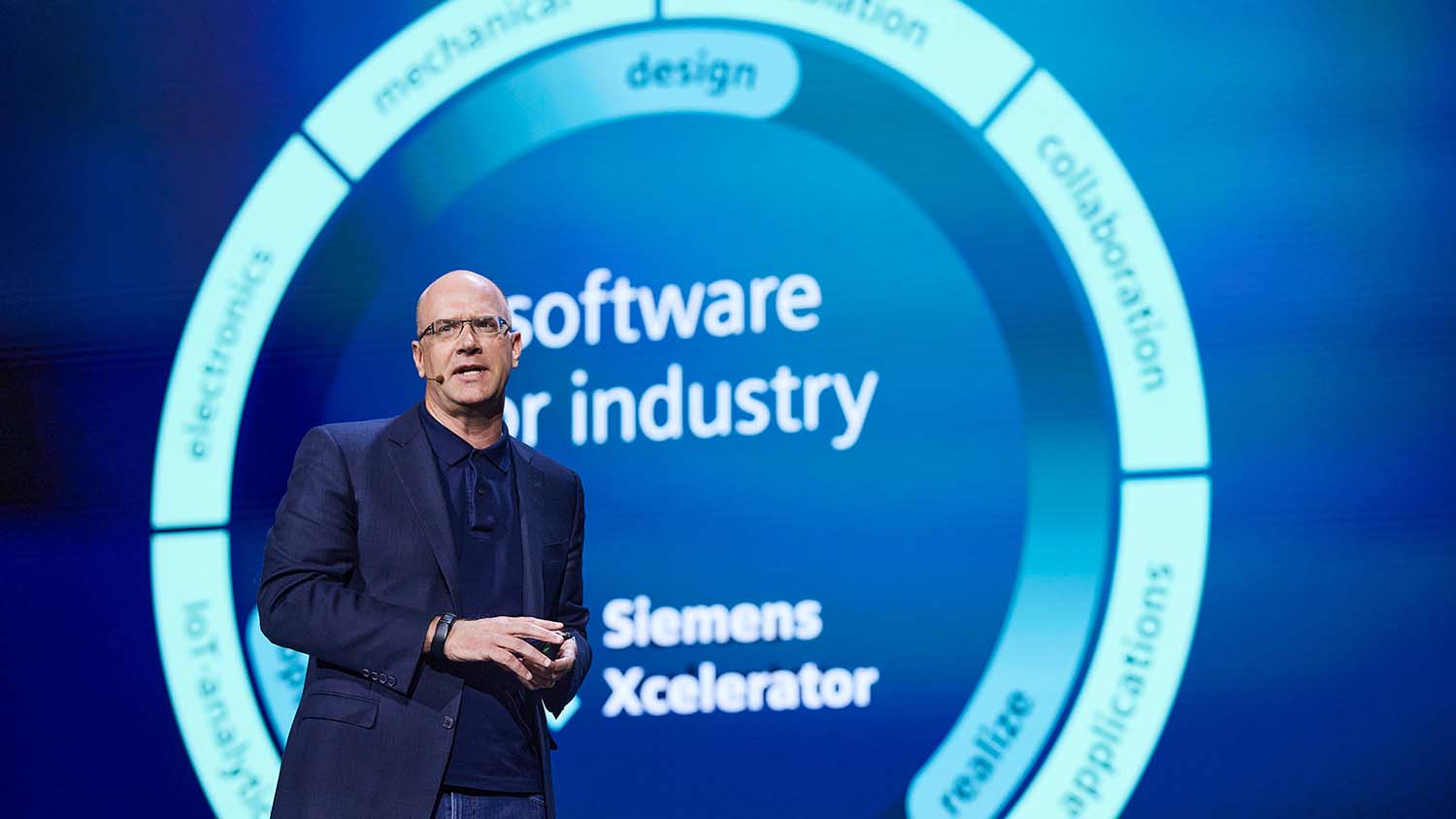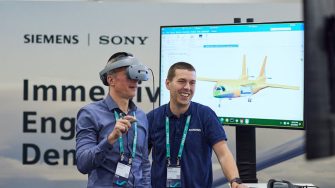Siemens is looking to the future, which at its Realize Live 2024 Americas event in Las Vegas meant lots of talk about producing AI and SaaS that users can embrace, Emilie Eisenberg reports
Artificial Intelligence (AI) was at the forefront of every presentation and conversation at Realize Live Americas 2024, as Siemens Digital Industries Software looks to AI integration to make every process quicker and easier for its users.
At this huge user event Tony Hemmelgarn, the CEO of Siemens Digital Industries Software, didn’t hold back in his plans for AI and his vision for it to play a role in every software customers use – from acting as a CAD co-pilot to speeding up simulation analysis.
“You may think that many things have been overhyped, but when it comes to AI, this feels different,” he said. “It feels different because we’re seeing immediate business value for our customers and frankly, the possibilities are endless when you think about what can happen.
“When a customer sees the true benefits then they understand how this will make a difference to their business – and it requires us to think a little bit differently.”
Hemmelgarn went onto to explain how Siemens thinks about AI in three areas: Analyse, Optimize and Generate.
The key element, Analyse, involves AI co-pilots built into Siemens software that allows users to interrogate design, engineering and manufacturing data to create the data we need with a simple prompt.
Then, with AI, everything from a production schedule to reconfiguring a factory floor can be optimised. Generate, he says, looks to use AI to automatically create a design specification, manuals or even geometry.
Uses for AI-enabled engineering, as explained by Siemens learning architect Jody Crossfield, range from domain-based user interaction models to guidance on sustainability and manufacturability predictions.
AI can anticipate the results of any decision made by the manufacturer, whether that decision is related to manufacture or traceability. It also acts as an intelligent search engine with optimised results.
Crossfield’s keynote talk on using predictive AI in NX X, the new SaaS based version of NX, demonstrated live how the AI industrial co-pilot can speed up the design process and eliminate the need for manual selection in CAD.
According to Crossfield, NX X’s AI can identify similar shapes, faces and areas, making editing less time-consuming and has a 94 per cent accuracy rate so far.
For Siemens’ simulation software, combining physics-based predictions with AI-based inferences can help augment the frequency and lower the turnaround time of simulation results, explained Jean Claude Ercolanelli, senior VP of simulation and test solutions.
By using AI to predict a product’s lifecycle it also leads to increased sustainability, with long-lasting materials chosen and the environmental impact of the product anticipated and reduced long before the product is manufactured and sold – particularly important when manufacturing transport such as cars and aeroplanes.
Realize Live 2024 // Cloud thinking

AI-enhanced solutions were also on the table when Siemens’ partnership with Microsoft took to the mainstage. The continuation of a 35-year partnership with Microsoft currently means that the Siemens Xcelerator as a Service portfolio can be run through Microsoft Azure and be integrated with Azure’s generative AI.
The expansion of the Xcelerator portfolio into Siemens Xcelerator as a Service was announced at the event by executive VP, PLM products, Joe Bohman, who outlined the new set of solutions that are available through the cloud.
The cloud market will surpass $1 trillion in 2026, Bohman said during the presentation, and it’s clear that Siemens wants to be a big part of that number.
NX X, Teamcenter X, Simcenter X, Opcenter X, and the Zel X engineering app are just some of the software that are now available through the Siemens Xcelerator as a Service portfolio.
Billed as ‘flexible, modular solutions run on the industry’s most robust interoperable data backbone’, the software available can fit workflows from concept to manufacturing.
“It brings together expert communities, giving people the ability to talk and work together,” said Bohman.
It also gives NX X users access to over 100 available products through the cloud, making it easy to run occasionally needed products without having to make a separate purchase.
The user experience is of the quality of NX, but with the additional means of collaboration that aren’t possible without the SaaS-based update.
It also makes tools like NX more accessible for more occasional users, with NX command predictor focussed on making the customer more efficient and productive, taking away the learning curve to get someone up and running with NX faster, said Jeff Miller, director of customer success marketing.
Aiding that learning curve was also the advances in realistic, immersive visualisation – especially important when considering the new generation of incoming product designers have grown up surrounded by video games and other forms of graphic design.
Bob Haubrock, senior VP of product engineering software, delivered a session on the importance of effectively connecting the real and digital world using immersive tools.
Siemens says it has improved its multidiscipline collaboration, graphics and colour to make the design process more seamless for a ‘gaming level experience’ even without a headset.
However, much of the opening keynote session was devoted to Siemens’ partnership with Sony, and the SRH-S1 headset developed to work in harmony with NX Immersive Designer was unveiled to the audience.
The Sony XR head-mounted display was designed specifically for use with NX and can be used to view and interact with models, providing a more immersive and authentic experience than that of looking at them on a desktop. When announcing the release of the headset, Seiya Amatatsu, head of Sony’s XR technology development division, claimed that it has improved its own design team’s productivity by 25 per cent. The headset will be available later this year.
Realize Live 2024 // On the floor
There was much to see in the Solutions Centre section of the event, where Siemens customers were invited to display new products and technologies.

A popular focus was low-code app development platform Mendix, bought by Siemens in 2018 and included in the Xcelerator portfolio.
Using Mendix, Siemens customers can view their manufacturing systems and workflows, build apps and share data through the cloud, reducing costs and the necessity of travel. A session called “How Applied Materials is Using Mendix” by from Applied Materials India outlined how the Material Product Manager Console App is establishing a Bill of Materials and managing product costs by using Mendix. The BOM data was centralised from Teamcenter and the open-source Java framework Hadoop.
Siemens also displayed the Maintenance Aware Design Ecosystem, or MADe, which identifies and mitigates technical risk and optimises design for engineering systems.
The system was created by PHM Technology as a solution to potential risk in engineering systems, with traditional manual methods of risk-checking no longer being practical as systems become rapidly more complex.
The slogan of Realize Live 2024 was ‘Where your digital transformation gets real. Fast,’ and MADe reflected this, supporting digital transformation by digitising risk and maintainability analysis.
“The importance of maintaining a digital system is often overlooked,” said presales solution consultant Marlene Haag. “But risk management is essential, especially when relying on the cloud.”
Digital transformation might require some risk management, but at Realize Live we saw the beginnings of Siemens’ cloud-based and AI-supported future.
It’s a move that is says will democratise its software portfolio and make it available to a wider range of companies. At the very least it opens up a world of new possibilities for what product development technology can become.






